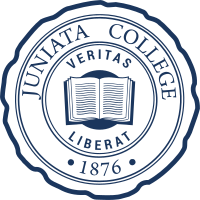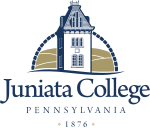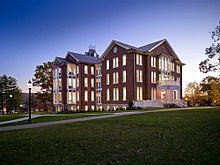Juniata College
This article needs additional citations for verification. (July 2008) |
 | |
Former names | Huntingdon Normal School (1876–1877) Brethren Normal School (1877–1896) |
|---|---|
| Motto | Veritas Liberat (Latin) |
Motto in English | Truth Sets Free |
| Type | Private liberal arts college |
| Established | April 17, 1876 |
| Affiliation | Church of the Brethren[1] |
| Endowment | $114.8 million (2020)[2] |
| President | James Troha |
Administrative staff | 403 |
| Undergraduates | 1,573[3] |
| Location | , , United States |
| Campus | Rural, 800 acres (3.2 km2) |
| Colors | Old Gold and Yale Blue |
| Mascot | Eagles |
| Website | www |
 | |
Juniata College (/ˌdʒuːniˈætə/)[4] is a private liberal arts college in Huntingdon, Pennsylvania. Founded in 1876 as a co-educational normal school, it was the first college started by members of the Church of the Brethren. It was originally founded as a center for vocational learning for those who could not afford formal education. As of 2015, Juniata College has about 1,600 students from 42 states and territories and 45 countries.[5]
History
[edit]19th century
[edit]
Huntingdon Normal School, a normal school, was established by a young Huntingdon physician, Dr. Andrew B. Brumbaugh, and his two cousins, Henry and John Brumbaugh. Henry provided a second-story room over his local print shop for classes, while John lodged and fed the college's first teacher, Jacob M. Zuck. Andrew was to "provide students and furniture".[6][7] Juniata's first classes were held on April 17, 1876, with professor Zuck teaching Rebecca Cornelius, Maggie D. Miller, and Gaius M. Brumbaugh, (the only son of physician Andrew Brumbaugh).[citation needed]
In 1877, the school changed its name to the Brethren Normal School. At this time Zuck also discussed adding a "Scientific Course" and issuing "Certificates of Graduation". In 1879, classes were moved into Founder's Hall, the school's first permanent building on the present-day campus then only known as "The Building". On May 11 of same year, Jacob Zuck died from pneumonia at age 32, which he probably caught from sleeping in the then unfinished Founders Hall without a heater. James Quinter was then chosen to lead the school as the school's first president.[7]
In 1894, due to a ruling at the Brethren Church's Annual Meeting against using the term "Brethren" in naming a school, the college was then renamed Juniata College for the nearby Juniata River, one of the principal tributaries from the west of the central Susquehanna River, which empties further south into the Chesapeake Bay. The name of Juniata College was made the school's legal name two decades later in 1896.[7]
In 1895, Dr. Martin Grove Brumbaugh (1862-1930), of Huntingdon County, Pennsylvania, an 1881 graduate from the Brethren Normal (Huntingdon Normal), took over the active presidency of now renamed Juniata College, leading the growing institution for 15 years until 1910.[citation needed]
He later became the 26th Governor of Pennsylvania, serving 1915-1919 at the newly-completed nine years earlier of the third Pennsylvania State Capitol in the state capital town of Harrisburg on the east bank of the central Susquehanna River.[citation needed]
Shortly after assuming the governorship in Harrisburg in January 1915, Dr. Brumbaugh also was recruited as a potential Republican Party presidential candidate in the following year's 1916 United States presidential election. He receiving more cast votes than any other in the several states party primary elections that spring and early summer of 1916. However the party's nomination went to Judge Charles Evans Hughes (1862-1941), then the associate justice of the United States Supreme Court at the 1916 Republican National Convention, meeting later that year in Chicago, Illinois. Unfortunately, Republican candidate and Justice Hughes lost the 1916 election to his opponent, the Democratic Party candidate and incumbent 28th President Woodrow Wilson (1856-1924, served 1913-1921), who was the victor and reelected to a second term. However, now former Associate Justice Hughes was later appointed by subsequent 31st President Herbert Hoover to later become the 11th Chief Justice of the United States serving again and heading the U.S. Supreme Court from 1930 to his death in 1941.[citation needed]
Governor Brumbaugh returned to Huntingdon and Juanita College after his 1915-1919 governorship five years later in 1924 to again assume the office of college president until his death while on vacation in North Carolina later in March 1930, after a second tenure of six years at his beloved Juanita.[citation needed]
20th century
[edit]During and after his tenure, Brumbaugh remained intimately connected to the college and reacquired the college's presidency in 1924, after having served as Governor of Pennsylvania from 1915 to 1919 and as commissioner of education in 1900 in the newly-acquired American possession of the former Kingdom of Spain/ Spanish Empire's island of Puerto Rico, after the Spanish-American War of 1898.[8] M. G. Brumbaugh died unexpectedly in 1930 while on vacation in Pinehurst, North Carolina, and was succeeded in his presidency by a former pupil at Juniata, Dr. Charles Calvert Ellis.[citation needed]
Presidents
[edit]- James Quinter (1879–1888)
- H.B. Brumbaugh (1888–1893)
- M.G. Brumbaugh (1893–1910)
- I. Harvey Brumbaugh (1910–1924)
- M. G. Brumbaugh (1924–1930)
- C.C. Ellis (1930–1943)
- Calvert N. Ellis (1943–1968)
- John N. Stauffer (1968–1975)
- Frederick M. Binder (1975–1986)
- Robert W. Neff (1986–1998)
- Thomas R. Kepple, Jr. (1998–2013)
- Jim Troha (2013–present)[9]
- Lauren Bowen, Acting President (2024)
Campus
[edit]

The main campus area is 110 acres (0.45 km2), and the college manages a 315-acre (1.27 km2) Baker-Henry Nature Preserve. Two new buildings since 2000 include the von Liebig Center for Science and the Suzanne von Liebig Theatre. Founders Hall, the first building on campus, has also been renovated recently. Construction was finished in the summer of 2009 and uses underground geothermal energy to heat and cool the building. This building is recognized as a LEED Gold building.[citation needed]
Other off-campus sites include the Baker Peace Chapel, designed by Maya Lin, and the cliffs, which have views of the Juniata River. The college also owns the Raystown Field Station, a 365-acre (1.48 km2) reserve on Raystown Lake, which includes a LEED Gold building and two lodges for semester-long residential programs, often focused on environmental topics.[10]
Athletics
[edit]
Juniata is a Division III collegiate sports institution. It is a charter member of the Landmark Conference, where it competes in all sports except football and volleyball. The athletic teams are known as the Juniata Eagles.[citation needed]
Football
[edit]The Juniata College football program is a member of the Landmark Conference. The Goal Post Trophy goes to the winner of the annual football game with rival Susquehanna University. It is a section of the goal post that was torn down after the 1952 Juniata-Susquehanna game. The visiting Indians (now Eagles) upset the Crusaders (now River Hawks) in Selinsgrove, and Juniata fans tore down the goal post after the game.[11]
Volleyball
[edit]Juniata College is known for both its men's and women's volleyball program. The men's volleyball team competes in the Continental Volleyball Conference; it previously competed in the Eastern Intercollegiate Volleyball Association, where it won several titles, even while under Division I and Division III sanctions. In 2023, the Juniata women's volleyball team won the NCAA D-III national championship. The Eagles completed a perfect season, going 35-0, earning the No. 2 seed in the D-III tournament and sweeping No. 4 Hope in straight sets, 25-22, 25-20, 25-21.[citation needed]
Notable people
[edit]Notable alumni
[edit]Notable alumni include:
- Ronald R. Blanck, former Surgeon General of the United States Army and chairman of the board of regents at Uniformed Services University of the Health Sciences
- Heidi Cullen, chief scientist for climate central and leads, World Weather Attribution program, and former first on-air climate expert at The Weather Channel
- Francis Harvey Green, former English Department chairman, West Chester University, and Pennington School headmaster
- Janet Kauffman, novelist
- Chuck Knox, former professional football head coach, Buffalo Bills, Los Angeles Rams, and Seattle Seahawks
- John Kuriyan, 2005 Richard Lounsbery Award winner and professor, biochemistry and molecular biology at the University of California, Berkeley
- Pat Malone, former professional baseball player, Chicago Cubs and New York Yankees
- Morley J. Mays, former Elizabethtown College president
- Wayne M. Meyers, former president, International Leprosy Association, physician, researcher, medical missionary, author of medical articles, book chapters, and books
- William Daniel Phillips, atomic physicist, National Institute of Standards and Technology, jointly awarded Nobel Prize in Physics in 1997 for his contributions to laser cooling
- Michael Trim, producer and cinematographer for the Showtime original series Weeds and executive producer and director of photography for the Netflix series Orange Is the New Black
- Carrie Schofield-Broadbent, Episcopal priest
- Frank Vogel, NBA coach, Indiana Pacers, Los Angeles Lakers, Orlando Magic, and Phoenix Suns
- Harriet Smith Windsor, former Delaware Secretary of State
Notable faculty and coaches
[edit]- Donald Deskey, art instructor who designed the interior of Radio City Music Hall and various Procter & Gamble products
- Regina Lamendella, biological sciences professor recognized for contributions to omics and microbiology[12]
- Fayette Avery McKenzie, sociology professor during the Progressive Era who promoted adult education and aided Native Americans and Black people
- Jerry Sandusky, former Penn State defensive coordinator convicted of 45 charges of sexual abuse of young boys over 15 years[13]
- Frank Vogel, former Kentucky Wildcats men's basketball player
References
[edit]- ^ "Colleges | Church of the Brethren". Brethren.org. Retrieved 2013-11-22.
- ^ As of June 30, 2020. U.S. and Canadian Institutions Listed by Fiscal Year 2020 Endowment Market Value and Change in Endowment Market Value from FY19 to FY20 (Report). National Association of College and University Business Officers and TIAA. February 19, 2021. Retrieved February 20, 2021.
- ^ "Juniata College - Just The Facts - About Our Students". Juniata.edu. Retrieved 2013-11-22.
- ^ "Juniata College - All Together Now: JOO-NEE-AT-UH!". Retrieved 2023-12-23.
- ^ "Juniata College Online Catalog". Juniata College. 2015. Archived from the original on March 23, 2015. Retrieved March 27, 2015.
- ^ "History". Juniata College. Retrieved 24 June 2015.
- ^ a b c Kaylor, Earl C. (1977). Truth Sets Free: A Centennial History of Juniata College, 1876-1976. South Brunswick: A.S. Barnes and Co., Inc. ISBN 0-498-02101-7.
- ^ Sigel, Nancy (2000). Juniata College: Uncommon Visions of Juniata's Past. Great Britain: Arcadia Publishing. ISBN 0-7385-0240-5. Retrieved 24 June 2015.
- ^ "Juniata College Past Presidents". Juniata College. 2015. Retrieved October 29, 2015.[permanent dead link]
- ^ "Juniata College- Raystown Field Station- Grove Farm". Juniata.edu. Archived from the original on 2015-04-02. Retrieved 2013-11-22.
- ^ "GO SU! - Susquehanna". Gosusqu.com. Retrieved 2013-11-22.
- ^ "Juniata Magazine".
- ^ Bachman, Denise; Karen Mansfield (November 20, 2011). "Childhood friends wonder if they really knew Jerry Sandusky". Observer–Reporter. Archived from the original on November 24, 2011. Retrieved November 22, 2011.
External links
[edit]- Juniata College
- 1876 establishments in Pennsylvania
- Universities and colleges established in 1876
- Huntingdon, Pennsylvania
- Liberal arts colleges in Pennsylvania
- Private universities and colleges in Pennsylvania
- Protestant universities and colleges in North America
- Universities and colleges affiliated with the Church of the Brethren
- Universities and colleges in Huntingdon County, Pennsylvania
